Woodbury (1910-1940)
Continued from: Woodbury
Continued onto: Woodbury (post 1940)
Legal disputes over the use of the Woodbury name and trademarks continued long after John H. Woodbury died in 1909. Foundation dates of companies that laid claim to the Woodbury name, products and/or trademarks following his death included: William A Woodbury Corporation (1914); William-Payne Corporation (1916); Woodbury Dermatological Institute (1917); William A. Woodbury Distributors, Inc. (1918); Woodbury, Inc. (1919); and the John H. Woodbury, and John H. Woodbury Laboratories (1925).
A number of these new companies involved Woodbury’s cousin, William Albert Woodbury. However, it seems likely that his role in many of these new businesses was restricted to the use of his name and connections to John H. Woodbury, the original Dermatological Institute, and the Facial Cultivating Company founded by John H. Woodbury in 1907.
A skin you love to touch
Of the eight Woodbury products Andrew Jergens bought from Woodbury in 1901, Woodbury Facial Soap was the most popular and continued to be the most heavily promoted by Andrew Jergens through to 1930 at least.
In 1910, Andrew Jergens gave the Woodbury account to the New York advertising agency, J. Walter Thompson, after it opened a branch in Cincinnati in 1908. The copywriter for the Cincinnati office, Helen Lansdowne Resor [1886-1964], developed the ‘A skin you love to touch’ tagline for Woodbury Facial Soap. It was first used in 1911 on the cover ‘The Woodbury book’ combined with an image of a woman having her hand kissed by a man, commissioned from the American artist Henry Hutt [1875-1950]. Like previous Woodbury publications, the book combined some basic information on the care of the skin and hair with details of Woodbury products. It could be bought for 50 cents and the first edition of 10,000 copies sold out (Cardwell, 1915, p. 99).
The first advertisement combining the Hutt image with the ‘A skin you love to touch’ tagline came later in 1911. The implication in the advertisment was that using Woodbury Facial Soap would give you sex appeal, a landmark idea in American advertising. It dramatically boosted sales which grew to US$2,147,000 by 1919 (AP&EOR, September, 1922, p. 417), most of the increase coming from sales of Facial Soap.
‘A skin you love to touch’ had to be free from blemishes and Andrew Jergens recommended using Woodbury Facial Soap to treat a wide range of skin problems including conspicuous nose pores, sallow skin, sluggish skin, blackheads, oily skin and shiny nose, and pimples. Treatments for these conditions combined Woodbury Facial Soap with some common beauty practices, specifically the use of hot water, hot cloths and/or facial steaming to open facial pores, then cold water and/or ice to close them. Two examples of suggested treatments are given below, the first for blackheads the second for sallow skin:
Apply hot cloths to the face until the skin is reddened. Then with a rough washcloth, work up a heavy lather of Woodbury’s Facial Soap and rub it into the pores thoroughly—always with an upward and outward motion. Rinse with clear, hot water, then with cold —the colder the better. If possible, rub your face for thirty seconds with a lump of ice. Dry carefully. To remove the blackheads already formed substitute a flesh brush for the washcloth in the treatment given above. Then protect the fingers with a handkerchief and press out the blackhead.
(Woodbury advertisement, 1919)
Fill your basin full of hot water—almost boiling hot. Bend over the top of the basin and cover your head and the basin with a heavy bath towel so that no steam can escape. Steam your face for thirty seconds.
Now lather a hot cloth with Woodbury’s Facial Soap. With this wash your face thoroughly, rubbing the lather well into the skin with an upward and outward motion. Then rinse well, first with warm water, then with cold. Finish by rubbing for thirty seconds with as piece of ice.(Woodbury advertisement, 1920)
The idea that Woodbury Facial soap was the only product needed to treat most skin blemishes became more difficult to maintain as beauty salons and beauty treatment creams proliferated in the 1920s. This would eventually lead Andrew Jergens to develop a complete Woodbury beauty range which began with introduction of Woodbury Cold Cream in 1919. However, this may not have been the first cold cream added to the Woodbury range. Andrew Jergens had created Woodbury Massage Cream shortly after it bought the eight Woodbury products in 1901 but it appears to have been abandoned by 1910.
Cold creams were commonly used as massage creams, skin cleansers, and/or night creams. To minimise any functional overlap with Woodbury Facial Soap, Andrew Jergens promoted Woodbury Cold Cream primarily as a night cream. This also enabled it to be used in combination with Woodbury Facial Cream, the vanishing cream introduced by John H. Woodbury back in 1891, sold to Andew Jergens in 1901. Like Pond’s, who introduced a cold cream/night, vanishing cream/day combination back in 1904-1905, both Woodbury creams were sold in tubes as well as jars.
Cold Cream: “A perfect cream for cleansing and massage. Contains the purest ingredients that not only cleanse, but sooth and soften the skin, keeping it active and healthy
Use it after exposure to dust, sun, wind and cold, and nightly before retiring. … Will not grow hair.”
Facial Cream: “This cream contains ingredients that are wonderfully soothing and healing for rough or chapped skins. Use it before going out. It disappears, heals and protects the skin from dust, sun and wind. … A perfect base for powder. Will not grow hair.”
Also see: Day and Night Creams
Andrew Jergens combined its Cold Cream, Facial Cream and Facial Soap to create a basic beauty routine:
1. Wring a cloth from hot water and hold it against the face to thoroughly open the pores. Then massage Woodbury’s Cold Cream well into the skin with an upward and outward motion, covering the face and neck thoroughly with the cream. Notice how gently it penetrates into the pores and softens and loosens the embedded dirt and dust particles.
2. With a clean soft cloth remove the surplus cream, always with and upward motion. Now, wash the face and neck thoroughly with warm water and Woodbury’s Facial Soap, working the creamy lather well into the skin so that it will dissolve and wash out the soiled cream which would otherwise remain in the pores. Rinse thoroughly with warm water or a small piece of ice wrapped in one thickness of cloth.
3. And now the final step. With the tips of your fingers, apply lightly Woodbury’s Facial Cream which tones the skin by supplying just the right amount of natural moisture without loading or clogging the pores. This finishing cream is greaseless and gives that soft, velvety texture so much desired.(Woodbury advertisement, 1927)
John H. Woodbury, Inc.
In 1929, Andrew Jergens bought John H. Laboratories, Inc., one of the alternative Woodbury companies that involved William A. Woodbury. In August, 1930, Andrew Jergens then created John H. Woodbury, Inc. and transferred to it all the Woodbury rights and business long owned by Andrew Jergens as well as those from the John H. Laboratories. At the same time, Andrew Jergens created the Jergens-Woodbury Sales Corporation to distribute Woodbury products. This was done to allow both companies to be registered in Ohio. This meant that any further Woodbury trademark disputes would have to be settled there and not in New York.
Facial Soap
Woodbury Facial Soap was repackaged in 1931 but came under increased competition from cheaper brands like Lux and Camay during the 1930s. The Great Depression of the 1930s forced Woodbury to lower the price of its Facial Soap from US25¢ to US10¢ in 1934 with its price falling to as low as US5¢ by 1939.
Skin-care
In 1930, nine new skin-care, hair-care and shaving products were added to the Woodbury range – Woodbury After Shaving Lotion, Hair Gloss, Cocoanut Oil Shampoo, Tar Shampoo, Liquid Castile Shampoo, Cleansing Cream, Tissue Cream, Facial Freshener, and Almond-Rose Cream. They all came in new package designs, joining Woodbury Cold Cream and Woodbury Facial Cream which had their containers updated in 1928. In 1932, in some of the darkest days of the Great Depression, Woodbury began selling the skin creams in larger jars for the same price, except for the Cleansing Cream which had its price reduced by one third.
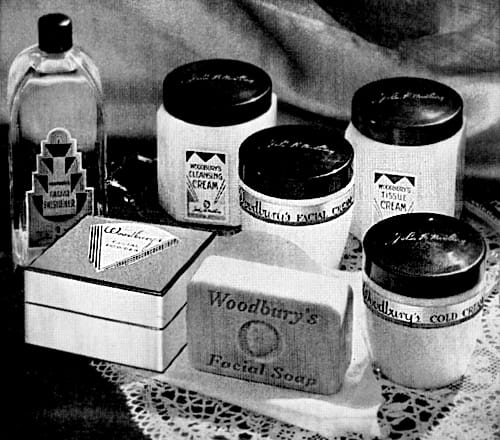
Above: 1931 Woodbury Facial Cleanser, Cleansing Cream, Facial Cream, Tissue Cream, Facial Powder, Facial Soap, and Cold Cream.
Cleansing Cream: “[A] very light, quick-melting cream for cleansing only. Excellent to flush out pore-deep dirt.”
Tissue Cream: “[A] high fat cream for upbuilding thin, under-nourished tissues of face and throat, to overcome extreme dryness, wrinkles, lines.”
Facial Freshener: “[A] refreshing liquid to remove excess cream, refine texture, tone up skin.”
Almond-Rose Cream: “[A] balm for chapped rough hands.”
After adding a wider range of beauty products to its inventory, Woodbury decided it needed a female beauty consultant to promote them. Rather than select a real person, the company invented one, Janet Parker, and then used her to promote the idea that Woodbury Facial Soap was an integral part of any facial routine.
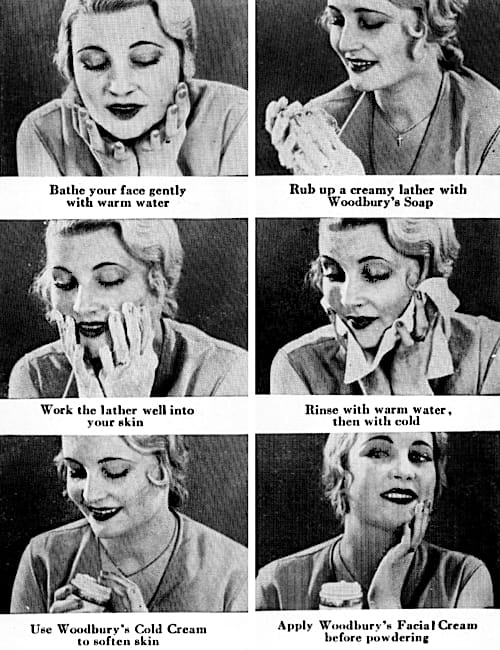
Above: 1931 Woodbury facial routine for normal skin.
Also see: The Index to Loveliness (1931).
In 1931, Woodbury then introduced three new skin lotions – Woodbury Skin Tonic and Astringent, Large Pore Lotion, and Blackhead Lotion – to treat a range of skin problems.
Skin Tonic and Astringent: “[A] stronger tonic lotion, especially formulated for flabby skin, a slow skin, an oily skin, and a course grained skin.”
Large Pore Lotion: “[A] penetrating cleanser and astringent. … It contracts open pores and refines the skin texture.”
Blackhead Lotion: “[A] cleanser and solvent to rid the pores of clogments.”
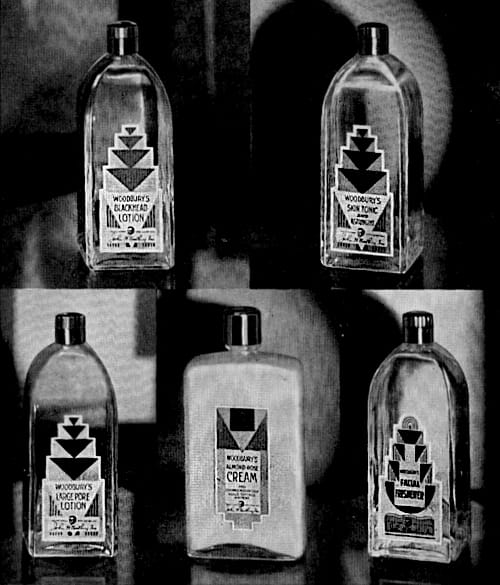
Above: 1931 Woodbury Blackhead Lotion, Skin Tonic and Astringent, Large Pore Lotion, Almond-Rose Cream and Facial Freshener.
The arrival of these new lotions required Woodbury to update its treatments for wrinkles, coarse pores, blackheads, pimples, flabby skin, and dull, sallow skin to include the use of these the new woodbury skin creams and lotions while maintaining the need for Woodbury Facial Soap. A example treatment for wrinkles is included below:
Wrinkles come when the natural oils of the skin are deficient, or when the skin fibers are lax and toneless. Thousands of Woodbury users have had gratifying results from this treatment:
AT NIGHT, Wash your face with warm water and Woodbury’s Facial Soap. Rinse with clear, warm water, then dash with cold water. If your skin is characteristically dry, apply Woodbury’s Cleansing Cream after washing your face. Then massage with Woodbury’s Tissue Cream, and leave on over night . . . If your skin is oily, use no creams after bathing your face at night. Instead, pat briskly with Woodbury’s Facial Freshener.
IN THE MORNING, Cleanse your face with Woodbury’s Cleansing Cream. Sponge and pat with Woodbury’s Facial Freshener, to tone and clear the skin. Apply Woodbury’s Tissue Cream, and if your skin is dry, leave Cream on while you bathe or work. . . If your skin is oily, wipe away excess Cream with Woodbury’s Facial Freshener.
BEFORE GOING OUT (and when renewing make-up), use Woodbury’s as in the morning (but omit this step if your skin is oily). Sponge and pat your face with Woodbury’s Facial Freshener. Smooth on Woodbury’s Facial Cream as a protective powder base. Apply Woodbury’s Facial Powder.(John H. Woodbury, Inc., 1933, p. 5)
See also: A Skin You Love to Touch (1933)
Germ-free
Skin hygiene remained the central narrative of these new Woodbury treatments. To reinforce this Woodbury began claiming in 1933 that it had added an ingredient to its Cold Cream and Facial Cream that made them germ-free.
Both Woodbury’s Cold and Facial Creams contain a scientific ingredient which keeps them are from germ-growth to the lat pinch in the jar. Blemish-germs cannot live in these creams.
(Woodbury advertisement, 1936)
Other beauty practices
Woodbury used a number of new beauty practices in its treatments in the 1930s. Like those used previously, these were adopted from other sources. The most extreme example of this occurred in 1934 when Woodbury added a series of rejuvenation exercises into its face and body treatments. Introduced by Dr. Joseph Pierron, described as a French skin specialist, the exercises were credited to Ninon de Lenclos [1620-1705], a French courtesan and patron of the arts. They used a long-held idea that wrinkles were skin folds caused by flabby facial muscles, a condition that could be rectified through facial exercises.
[N]o muscle on the human frame can retain its elasticity and tone less it is exercised. It grows flaccid and relaxed, or stiff from inertia. As people grow older the muscles of the face are the first to show signs of relaxation. They grow stretched and flabby, like a piece of old elastic, not from overuse, but from neglect.
(Perron, 1934, p. 14)
See also: Facial Gymnastics
It seems likely that Woodbury took the exercises directly from a 1912 book written by the physical culture writer, Sanford Bennett [1841-1926] – ‘Old age its cause and prevention: The story of an old body and face made young’. All the exercises used by Woodbury in 1934 were illustrated in Sanford Bennett’s book who also credited them to Ninon de L’Enclos.
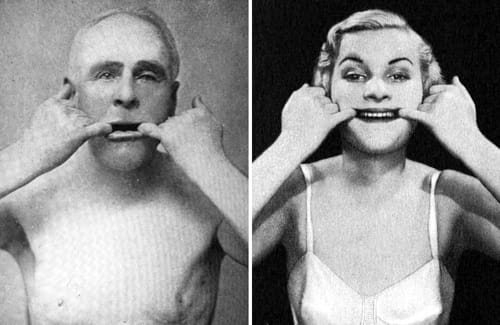
Above: Exercises to correct a drooping mouth. Stanford Bennett (left), Woodbury (right)
See also: The beauty secret of the woman who never grew old (1934)
Dry skin
Most Woodbury skin-care advertising in the 1930s concentrated on Woodbury Cold Cream and Facial Cream. Woodbury did not have a specific dry skin cream in its inventory but added Element 576 to the Woodbury Cold Cream in 1932 to ‘increase cellular activity and the production of oil’. This approach was based on the idea, current at the time, that dry skin lacked oil (sebum) not moisture.
Element 576, never before incorporated in any face cream, is similar in essence to the vitamin principle in foods which bring the body energy, vitality. Now, Woodbury’s Cold Cream with the new Element 576, arouses the skin to greater activity. And so, the little oil glands that lie just beneath the skin, secrete more actively the oil that alone keeps the surface fresh and supple, secure against the harmful thieving of the sun!
(Woodbury advertisement, 1933)
See also: Dry Skin Treatments
Vitamin D
In 1936, Woodbury also added vitamin D, often referred to as the ‘sunshine vitamin’, to Woodbury Cold Cream, Woodbury Tissue Cream and Woodbury Facial Soap. Advertisements for Woodbury Facial Soap with vitamin D gained attention through their liberal use of nudes, another American advertising landmark.
AT LAST Science has found a way to irradiate the greatest qualities of sunshine into one of the ingredients of Woodbury’s Facial Soap!
Everyone knows that Sunshine, in careful measure, is a natural skin beautifier . . . that certain rays burn and destroy the skin, while others help to enhance its loveliness.
Now, by a marvelous new process, excluding and patented, the beneficial rays are irradiated into an ingredient of this world-famous soap. This makes it rich in Vitamin D, the sunshine vitamin. And tests by a great American university prove that their “Filtered Sunshine” ingredient—Vitamin D—in Woodbury’s is readily absorbed by the skin.(John H. Woodbury, Inc., 1936)
The claim that Vitamin D was readily absorbed by the skin bought Woodbury into conflict with the Federal Trade Commission (FTC) in 1941 after the passing of the Wheeler-Lea Act of 1938.
See also: The FDA, FTC and Cosmetics
Make-up
In 1931, Woodbury repackaged its Facial Powder, which now came in six shades. Two years later, it added an indelible lipstick housed in a push-up tube and a compressed powder rouge, both in the same four shades.
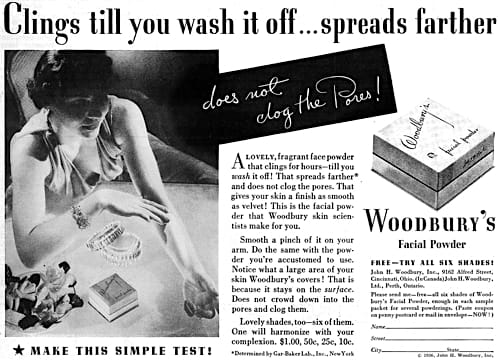
Above: 1936 Woodbury Facial Powder.
Woodbury Facial Powder: “[M]ade from pure, carefully selected ingredients. It is formulated not to clog, stretch or enlarge the pores. It will not cause blackheads or other blemishes, will not irritate the skin.” Shades: Natural Cream, Rachel, Radiant, Flesh, Blonde, and Brunette. Later shades included Windsor Rose (1937); Champagne, and Blush Rose (1939), and Tan.
Woodbury Rouge and Lipstick: “[E]qually harmless—can be safely used on sensitive skins.” Shades: Natural, Flame, Raspberry, and Poppy, with Burgundy, and Blush Rose added in 1939.
See also: Woodbury Powder Shade Chart and Woodbury Rouge and Lipstick Shade Chart
Using the same shade names for its lipsticks and rouges made it easier for Woodbury to colour coordinate them with an appropriate shade of powder.
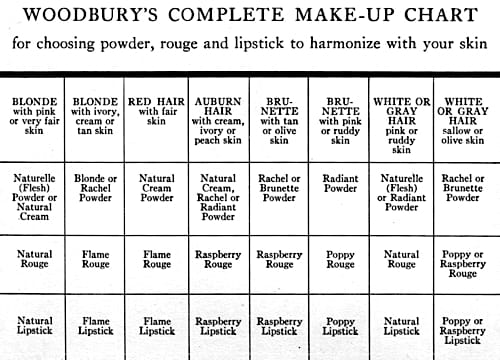
Above: 1934 Woodbury Complete Make-up Chart.
During the 1930s, Woodbury repackaged its Facial Powder more than once before it appeared in a blue boudoir box with Greco-Roman figures on the lid in 1937. This coincided with the new Windsor Rose shade which, I assume, was in honour of the 1937 coronation of George VI who was from the House of Windsor. The powder was still labelled as germ-free and, to ensure customers got the message, advertisements warned about the dangers of seborrhea, which Woodbury said could be made worse by germs. Like the germ-free claims Woodbury made for its face creams, the germ-proof make-up claims created problems with the FTC.
Woodbury also claimed that its rouges and lipsticks were ‘germ-proof’.
WOODBURY TREATMENT FOR NORMAL SKIN
A least twice a day—always at bedtime, bathe your face with warm water end a lather of Woodbury’s Facial Soap, rubbed up on your hands or on a soft wash cloth, Work this gently into your skin as you would a cream. Rinse with warm water, then with cold.
After the Nightly Cleansing with Woodbury’s Facial Soap, apply Woodbury’s Germ-free Cold Cream, Leave a little on overnight. This cream like all of Woodbury’s Beauty Creams, stays germ-free to the last dab, An added protection against blemish-germs which may attack the skin from the outside. Element 576 in Woodbury’s Cold Cream aids in combating skin dryness.
In the Morning use Woodbury’s Facial Soap and tepid water, Rinse with cold water.
Before Going Out smooth on Woodbury’s Germ-free Facial Cream. This guards the skin from wind and dust, and forms a perfect foundation for make up. Apply Woodbury’s Germ free Facial Powder, Germ-proof Rouge and Germ-proof lipstick.(John H. Woodbury, 1936)
The new blue powder container introduced in 1937 did not last long as the entire Woodbury range was repackaged late in 1938. Most notable in this redesign was the widespread replacement of the neckless head image of John H. Woodbury with a gothic letter ‘W’.
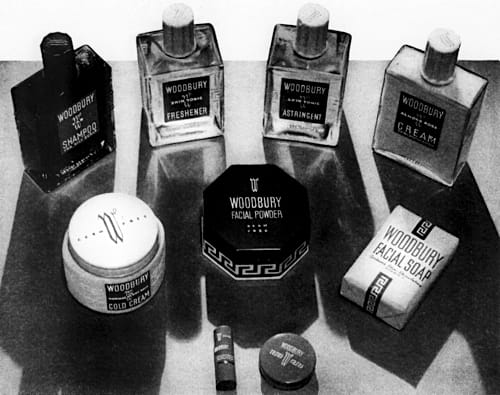
Above: 1939 New Woodbury packaging, some items with a Greek border design, developed by the New York design firm of De Vaulchier, Blow and Wilmet.
The new packaging topped of a fairly successful decade for Woodbury but it was now firmly placed as a budget brand. Andrew Jergens seems to have accepted this positioning as it ceased advertising Woodbury in Vogue in 1940.
Timeline
| 1911 | ‘A skin you love to touch’ campaign begins. |
| 1919 | New Products: Woodbury Cold Cream. |
| 1928 | Cold Cream and Facial Cream jars repackaged. |
| 1930 | John H. Woodbury Inc. founded; and the Jergens-Woodbury Sales Corporation established. New Products: After Shaving Lotion; Hair Gloss; Cocoanut Oil Shampoo; Tar Shampoo; Liquid Castile Shampoo; Cleansing Cream; Tissue Cream; Facial Freshener; and Almond-Rose Cream. |
| 1931 | Facial Soap repackaged. New Products: Skin Tonic and Astringent; Large Pore Lotion; and Blackhead Lotion. |
| 1933 | Burbank factory expanded. New Products: Lipstick and Rouge. |
| 1937 | Facial Powder repackaged. |
| 1938 | Woodbury range repackaged. |
Continued onto: Woodbury (post 1940)
First Posted: 1st June 2023
Sources
The American perfumer & essential oil review. (1906-1955). New York: Robbins Perfumer Co. [etc.].
The Andrew Jergens Co. (1911). The Woodbury book. Cincinnati, Author.
The Andrew Jergens Co. (c.1927). A skin you love to touch: A book of the most famous skin treatments ever formulated [Booklet]. USA: Author.
Cardwell K. C. (1915). Popularizing a twenty-five cent soap in face of ten-cent products: What the Andrew Jergens company accomplished with Woodbury’s facial soap. Advertising & Selling. September, (4), 9, 98-100.
The drug and cosmetic industry. (1932-1997). New York: Harcourt Brace Jovanovich [etc.].
John H. Woodbury, Inc. (1933). A skin you love to touch: The scientific way to loveliness [Booklet]. USA: Author.
John H. Woodbury, Inc. (1934). A skin you love to touch: The scientific way to loveliness [Booklet]. USA: Author.
John H. Woodbury, Inc. (1936). Bathe yourself in sunshine [Booklet]. Cincinnati, OH: Author.
John H. Woodbury, Inc. (1936b). Beauty . . . twice as lovely twice as sure [Booklet]. Cincinnati, OH: Author.
Parker, J. (1931). The index to loveliness. U.S.A.: John H. Woodbury, Inc.
Perron, J. (1934). The beauty secret of the woman who never got old [Booklet]. USA: John H. Woodbury, Inc.
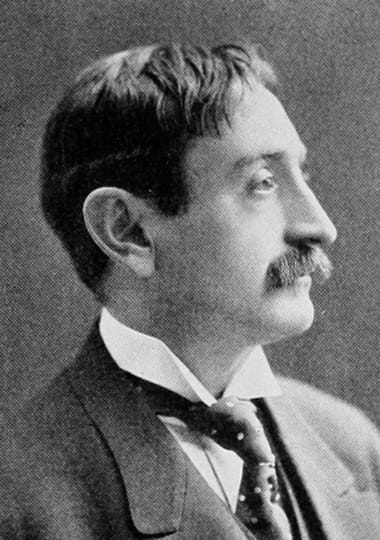
William Albert Woodbury [1866-1957]. His name was used in a number of Woodbury companies founded after his cousin John H. Woodbury committed suicide. He joined the John H. Woodbury Dermatological Institute in 1892 and was also involved in the Facial Cultivating Company founded by John H. Woodbury in 1907. Like his cousin, William Woodbury referred to himself a dermatologist and also wrote a number of books including: ‘Beauty culture’ (1911); ‘How to get thin and how to acquire plumpness (1915); ‘The care of the hair and the scalp’ (1915); ‘Hair dressing and tinting’ (1915); ‘The care of the hand’ (1915); ‘The care of the face’ (1915); and ‘The care of the foot’ (1915).

1911 Woodbury Facial Soap.
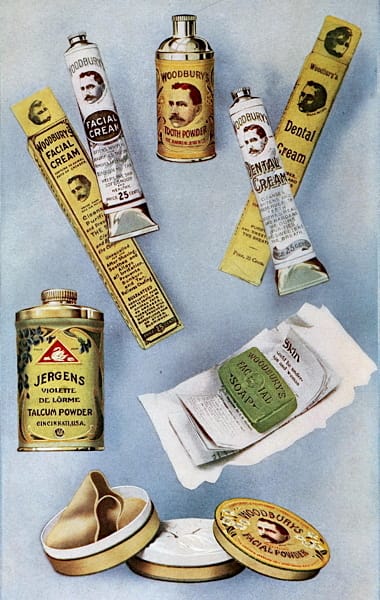
1911 Woodbury Facial Cream, Tooth Powder, Dental Cream, Facial Soap, and Facial Powder, and Jergens Violet de Lôrme Talcum Powder with the neckless head trademark prominent on Woodbury products.

1915 Woodbury Facial Soap.

1916 Woodbury Facial Soap.
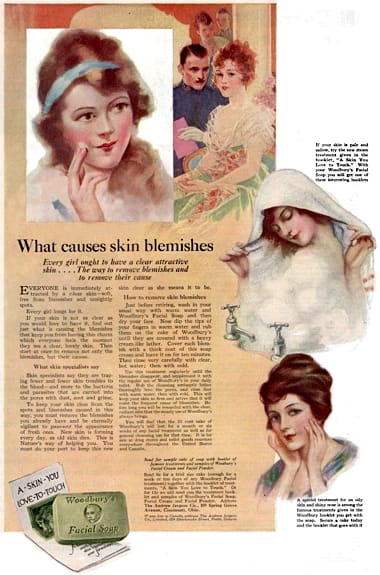
1918 Woodbury Facial Soap. Note the suggestion to ‘steam’ the face.
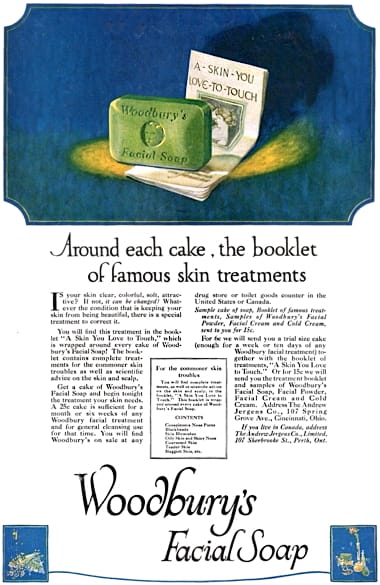
1919 Woodbury Facial Soap.
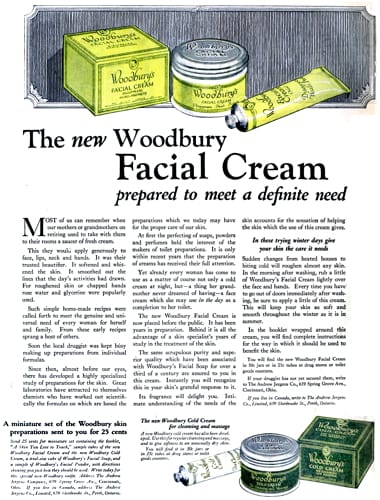
1920 Woodbury Cold Cream and Facial Cream.
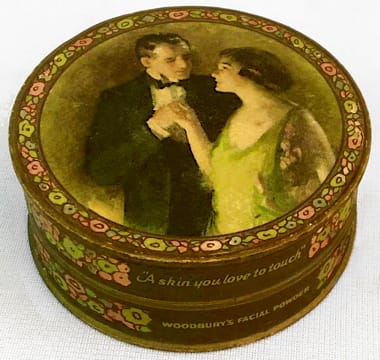
Woodbury Facial Powder.
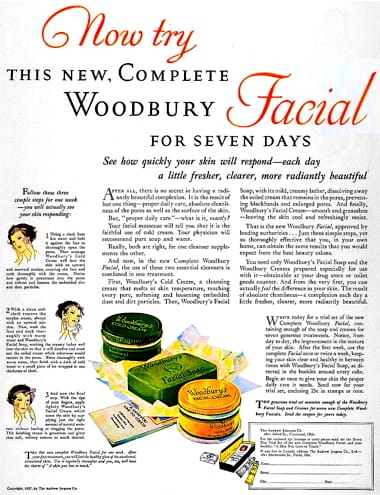
1927 Woodbury facial routine.
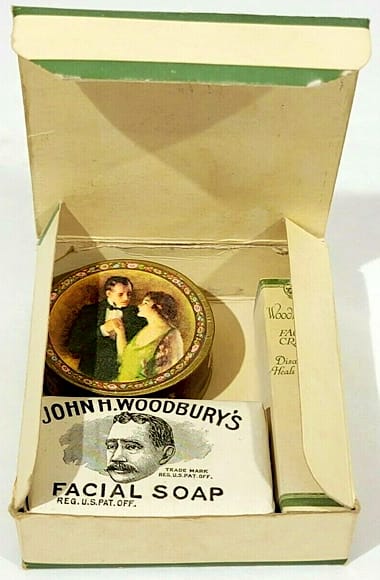
Woodbury Treatment Box with Woodbury Facial Powder, Facial Soap and a tube of Facial Cream.
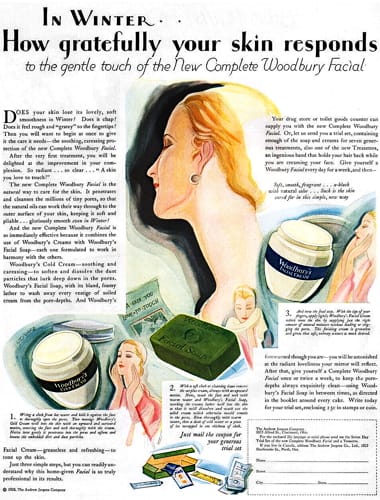
1928 Woodbury Cold and Facial Creams in new jars.
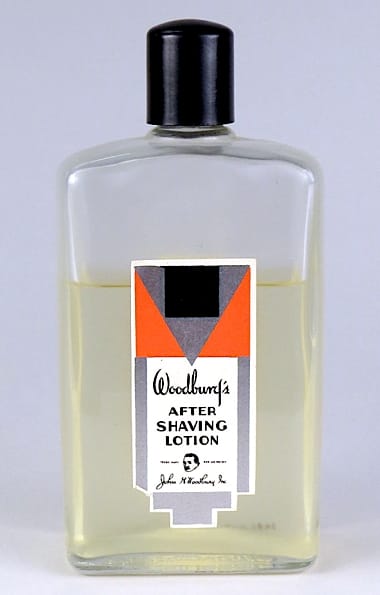
Woodbury After Shaving Lotion.
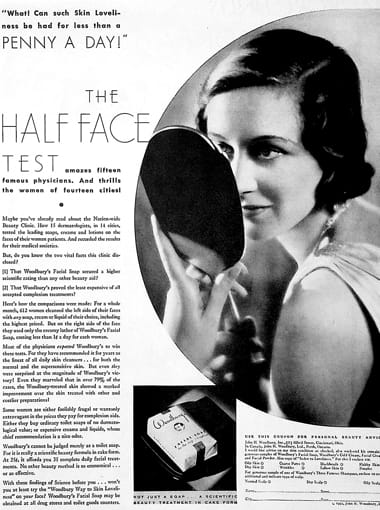
Woodbury Half-Face Test used widely in the 1930s to promote Woodbury Facial Soap.
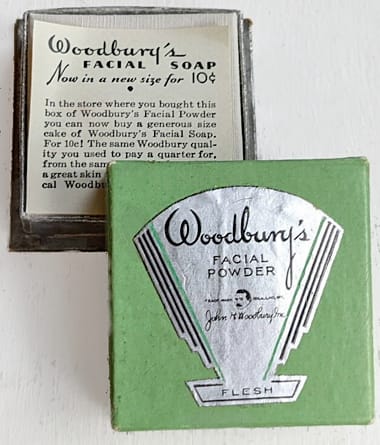
c.1933 Woodbury Facial Powder.
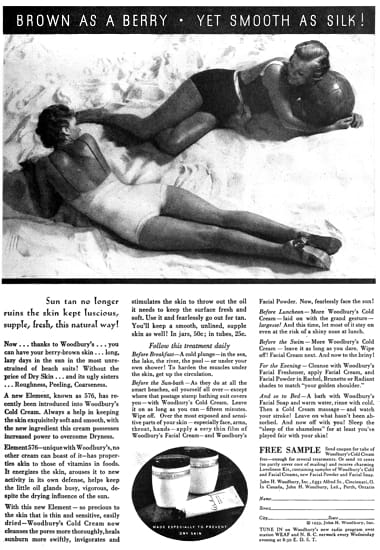
1933 Woodbury Cold Cream with Element 576 and Woodbury Facial Cream.
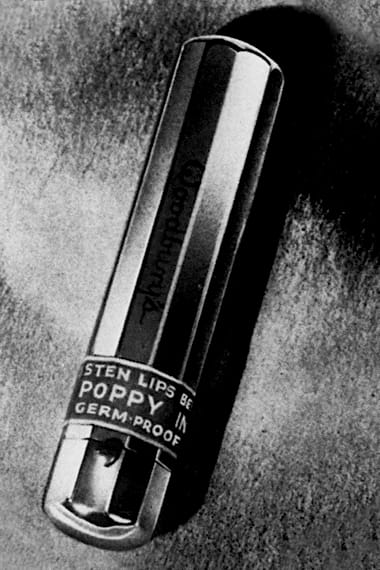
1935 Woodbury Poppy Germ-Proof Lipstick.

1936 Woodbury Facial Soap. The ‘filtered sunshine’ campaign began in 1935 after Woodbury added vitamin D, ‘the sunshine vitamin’, to its Facial Soap. Advertisements were noted for their use of nudes.
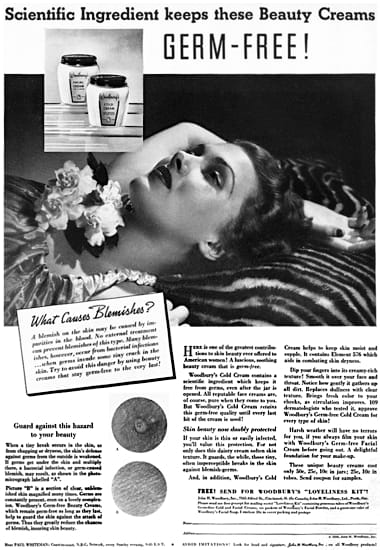
1936 Woodbury Germ-Free Cold Cream and Facial Cream.
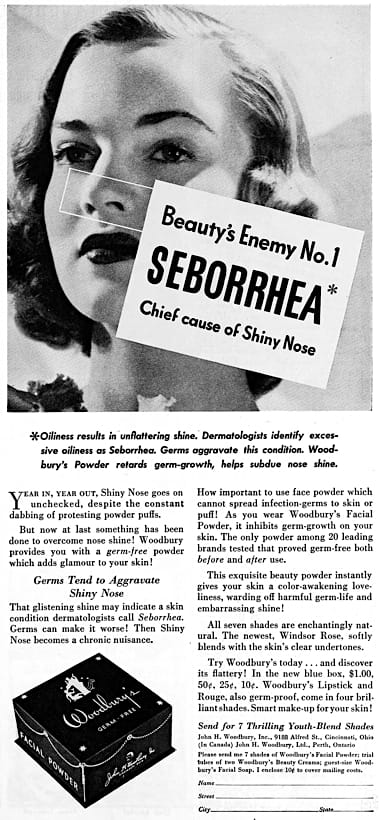
1938 Woodbury Facial Powder.
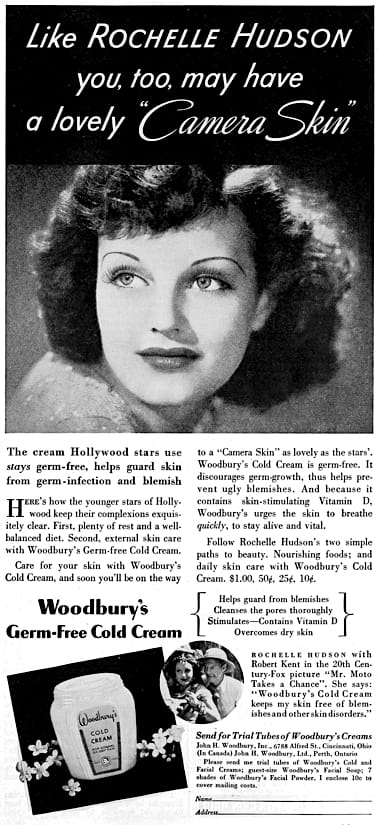
1938 Woodbury Camera Skin.
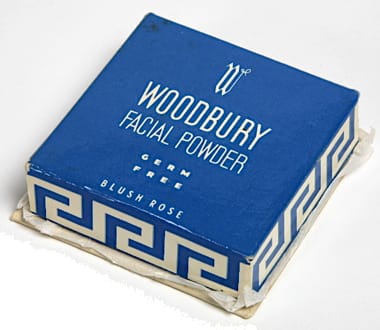
Woodbury Blush Rose Germ Free Face Powder in packaging introduced in 1938.
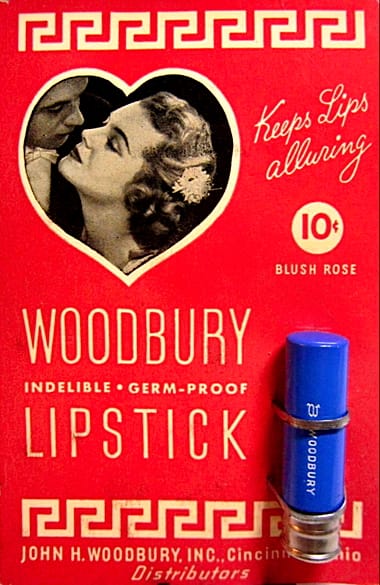
Woodbury Blush Rose Germ-Proof Lipstick.
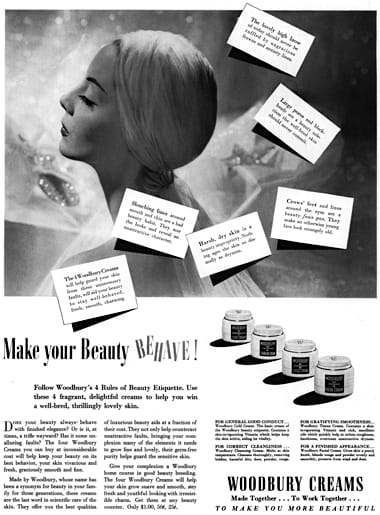
1939 Woodbury Cold Cream, Cleansing Cream, Tissue Cream, and Facial Cream in new packaging.
